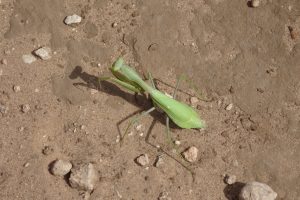20-22 September: Crossing the Panhandle of northern Texas, we camped and hiked in Palo Duro Canyon State Park, a very attractive getaway destination near Amarillo. Here the Prairie Dog Town Fork of the Red River has eroded a big canyon into the eastern escarpment of the Llano Estacado, the very large and flat plateau of northwest Texas and eastern New Mexico. The steep canyon walls have exposed colorful sedimentary rock layers formed over many millions of years.
We hiked from the canyon floor up the Rock Garden Trail to the canyon rim, and then along the canyon rim for a while before stopping for lunch at a good outlook and then returning by the same trail, about six miles total. The hiking was easy, traversing interesting and varied terrain, and not crowded at all. We learned to recognize mesquite, which are shrubs or small trees of several related species known for their hard wood (palo duro = “hard stick”) and edible seed pods. Mesquites have feathery-looking leaves, almost fernlike, and long sharp thorns on the branches; enrich the soil by nitrogen fixation; and are very hardy in arid areas. They are considered to be problematic invasive species in some areas where they have been introduced.


We wondered what animal left the large scat on the trail that was full of seeds of prickly pear cactus (some of them now bearing very ripe fruit). A few hoof prints that we saw on dusty sections of the trail were not as sharp-pointed as deer or pronghorn tracks and some seemed a bit too large for javelina—were they possibly wild boar or introduced barbary sheep?


For a run in the late afternoon, it seemed appropriate to head out on the Givens, Spicer, Lowry Trail. Named for avid runners who helped build the park’s trail system, this trail is generally fairly level and it has very nice views. Wild turkeys are a common sight in the park. We noticed some of them flying up into the large trees behind our site to roost both nights we camped there.



